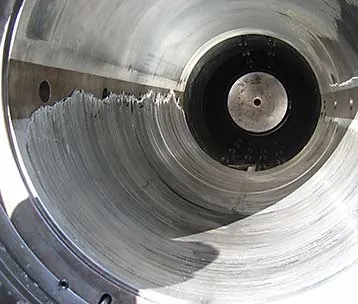A surge of stern tube bearing failures since 2014 has been extensively investigated by DNV GL. One of the major questions to answer is whether the performance of the newly introduced environmentally acceptable lubricants (EALs) is equivalent to the traditional mineral oils used in stern tubes.
Relevant for ship owners and managers, yards, suppliers, design offices and flag states
The introduction of the Vessel General Permit (VGP) requirements in 2013 resulted in a sudden and massive uptake of environmentally acceptable lubricants (EALs) as stern tube lubricants for ships. This trend coincided with a reported widespread increase in the number of stern tube bearing failures, and it was inevitable that the maritime industry started to question the actual lubrication performance of the EALs.
Trying to bridge the obvious knowledge gap in the industry, DNV GL, together with the insurers – the Swedish Club, the Norwegian Hull Club, Gard and Skuld – initiated a joint EAL development project (JDP) in late 2017 to investigate the topic. The primary aim of the project was to map out potential differences in the lubrication capabilities of EALs compared to traditional mineral oils for a stern tube application.
Most of the observed failures were found to happen very early in the lifetime of the vessels, and during operating conditions known to inflict significant shaft deflections in way of the aft bearing. Operations such as extreme turning in the upper speed range are known to inflict very high localized loads on the aft end of the aft stern tube bearing. The first phase of the JDP thus focused on studying the core lubricant properties affecting the load-carrying capacity.
From a design perspective, the lubricant viscosity is a key property that must be chosen correctly to ensure that hydrodynamic lubrication is given in all continuous operating conditions. The DNV GL study has, however, discovered two specific viscosity-related characteristics where EALs differ from mineral oils. These properties will affect the safety margin of the aft stern tube bearing in certain critical operating conditions.
Firstly, the pressure-viscosity coefficient of typical stern tube EALs is different than that of the same-grade mineral oil. The practical consequence of this difference is that under the high-load operating conditions typical for the observed aft stern tube bearing failures, an EAL will operate with a lower true viscosity in the minimum oil film thickness region. Knowing that the viscosity is proportional to the oil film thickness and load-carrying capacity of a journal bearing, it is understood that the safety margin is reduced for an EAL installation in the high-load running modes (see figure 1).
Secondly, the viscosity index is significantly higher for EALs compared to mineral oils. This means that the EALs will operate with a much lower viscosity in the lower temperature region (see figure 2) typical for stern tubes in certain conditions such as mooring trials and cold start-up. Again, the safety margin will be reduced in those types of operation.
ConclusionTo retain the safety level of a mineral oil installation, there are in practice two options: either increasing the specified viscosity of the EAL (one viscosity grade up) or optimizing the aft stern tube bearing design to increase the shaft-bearing contact area and reduce the peak pressure in the lubricant film. |
New DNV GL design rule criteria
Based on this conclusion, DNV GL has revised the main class shaft alignment rules from July 2019 to achieve an equivalent safety margin for the aft stern tube bearings intended to be operated with an EAL. The rule update /ref4/ includes the introduction of a viscosity influence parameter in the hydrodynamic oil film lubrication acceptance criteria, differentiating between EALs and mineral oils. This requirement is not retroactive for vessels which comply with older class rules.
Aft propeller shaft bearing performance, critically influenced by key factors such as the shaft-bearing contact area, oil viscosity, RPM, diameter of the shaft, bearing load, etc. requires detailed evaluation of hydrodynamic lubrication conditions. DNV GL is the only class society requiring the verification of satisfactory hydrodynamic lubrication in selected representative continuous operating conditions and, consequently, considering lubricant viscosity as well as the type of stern tube lubricants /ref3/. Based on experience and internal research, DNV GL had also earlier in 2018 updated the main class shaft alignment rules for single stern tube bearing installations and introduced the optional class notations Shaft align (1) and (2).
Note: Medium to long-term lubricant degradation mechanisms affecting, for instance, seal wear rates have not been considered as part of phase 1 of the EAL JDP. Such aspects will be investigated in the coming phases of the project.
Recommendations
Requirements and recommendations in case of EAL application at the newbuilding and operational phases to maintain safety margins as it would be for mineral oil applications:
- Vessels with applicable DNV GL design rules from July 2019 or later – new shaft alignment rule criteria is mandatory
- Vessels with applicable design rules older than July 2019 – not mandatory (but recommended to switch to the next higher viscosity grade above design specification)
- All vessels – ensure seal compatibility and carry out proper system monitoring in accordance with oil and seal makers‘ recommendations
References and more information
- 29 Oct 2019: WEBINAR on “Environmentally acceptable stern tube lubricants – how to avoid costly failures”
- DNV GL news: DNV GL launches new JDP to test biodegradable lubricants (Jan 2018)
- DNV GL news: DNV GL: Performance of EALs triggers update to shaft alignment rules (June 2019)
- DNV GL rules for ships (Shaft alignment) July 2019 – Part 4 Chapter 2 Sec 4
- Expert article: Ensuring satisfactory aft stern tube bearing lubrication performance
- Slideshow: Major findings of EAL study
Contact
- For customers: DATE – Direct Access to Technical Experts via My Services on Veracity
- Otherwise: Use our office locator to find the nearest DNV GL office.
